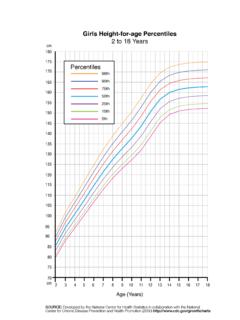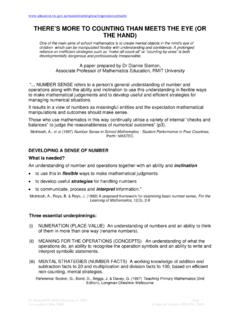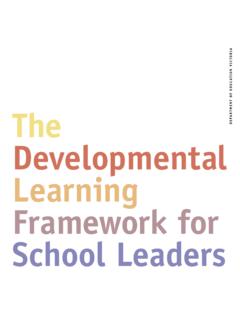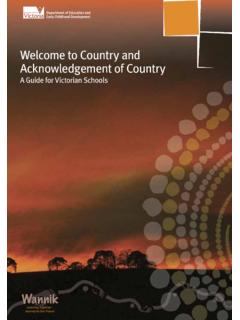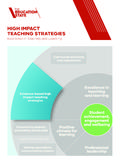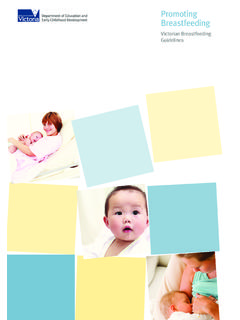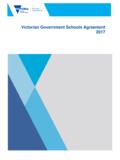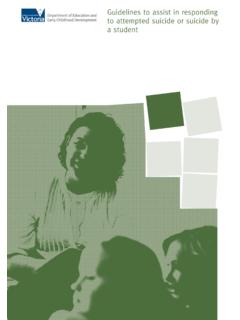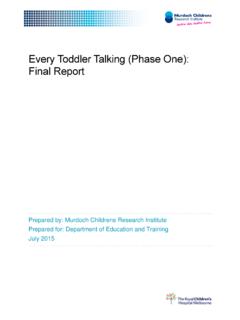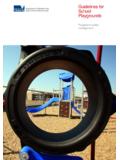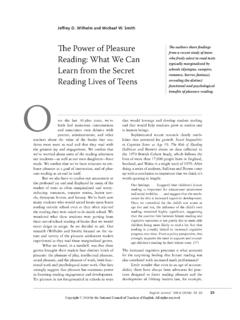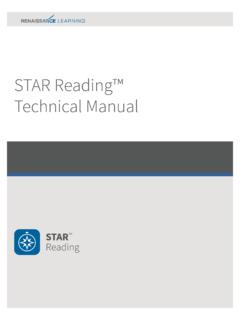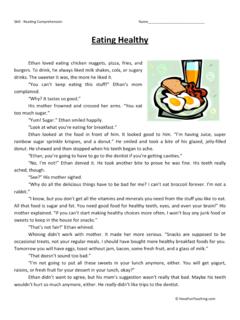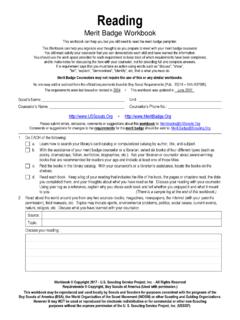Transcription of Reading Recovery Guidelines - education.vic.gov.au
1 These Guidelines aim to maximise Reading Recovery effectiveness in Victorian schools and assure the provision of a quality intervention for students. The Guidelines reflect the intent of the Australian National Standards which are based on research and current effective practice. Last updated: (c) State of Victoria, 2007 Dept of Education Reading Recovery Guidelines 2007 Page 2 of 21 Overview of Reading 4 Students participating in Reading 5 Identifying students requiring Reading 5 How are students selected?.. 5 An Observation Survey of Early Literacy 5 New 6 Transferred 6 Intervention 7 Discontinuing the Lessons Series for 7 Two positive 7 Effective monitoring .. 7 Students Referred from Reading 8 Home School Support 8 The Reading Recovery 10 Structure of a 10 Reading Recovery 11 Effective 11 Professional 11 School 11 Cost 11 Data 11 Expressions of 12 Parent 13 Reading Recovery in Small 14 The Reading Recovery 15 Selection of a Reading Recovery 15 The training 15 Ongoing 16 Returning after an 16 The Reading Recovery 17 Teaching 17 Initial 17 Ongoing 17 Program 17 Reading Recovery Tutors.
2 17 Professional Returning after an 18 The Reading Recovery 19 Training 19 Reading Recovery 19 Dept of Education Reading Recovery Guidelines 2007 Page 3 of 21 Professional 19 Teaching 19 Establishing a Reading Recovery Inservice 20 Important Guidelines for the establishment of an Inservice 20 Specification 20 20 20 Sound 20 21 Dept of Education Reading Recovery Guidelines 2007 Page 4 of 21 Overview of Reading Recovery Students are selected for Reading Recovery based on individual measures of assessment and teacher judgment. Their classroom literacy program is then supplemented with daily one-to-one lessons of thirty minutes. The series of lessons runs for 12-20 weeks with a specially trained teacher. The lessons consist of a variety of experiences designed to help children develop effective Reading and writing strategies. Reading Recovery continues until the child can read within or above the class average and has demonstrated the use of independent Reading and writing strategies.
3 The student s lesson series is then discontinued , providing the opportunity for another student to be selected for Reading Recovery . The remarkable progress made by children participating in Reading Recovery demonstrates that high percentages of at-risk students can achieve success. The key to success is intervention with specialised teaching that will enable students to improve quickly before they are labelled as failures. Essential to the success of Reading Recovery is the intensive inservice Experienced early years literacy teachers participate in a year-long inservice program conducted by a trained Reading Recovery Tutor. The year-long program integrates theory and practice and is characterised by intensive interaction with colleagues. Following this training year, teachers continue their specialised professional development through ongoing interaction with their colleagues, Tutors and Reading Recovery Trainers Through training Reading Recovery teachers become literacy specialists developing keen observational skills and a repertoire of intervention strategies that can be adapted to meet the individual needs of at-risk students.
4 The training of Reading Recovery teachers is the responsibility of fully qualified Reading Recovery Tutors. Prior to appointment, Tutors undertake a year long training program that covers both theoretical and practical areas of literacy development. Dept of Education Reading Recovery Guidelines 2007 Page 5 of 21 Students participating in Reading Recovery Identifying students requiring Reading Recovery Reading Recovery is designed for children who are the lowest achievers in the class/age group. What is used is an inclusive definition. It is sometimes argued to exclude this or that category of children or to save places for children who might seem to benefit the most but that is not using the full power of the program. It has been one of the surprises of Reading Recovery that all kinds of children with all kinds of difficulties can be included, can learn and can reach average-band performance of their class in both Reading and writing achievement.
5 Exceptions are not made for children of lower intelligence, for second-language children, for children with low language skills, for children with poor motor coordination, for children who seem immature, for children who score poorly on readiness measures, or for children who categorised by someone else as learning disabled. Clay, M. 1991, Reading Recovery Surprises in Bridges to Literacy. Deford, D., Lyons, C. a. & Pinnell, G. S. (Eds.) p. 60 How are students selected? At the beginning of each year, children in Year 1 who are having literacy learning difficulties are selected for Reading Recovery . One of the key ways in which students are selected for Reading Recovery is through an Observation Survey of Early Literary Achievement (Clay M. M. 2002, 2006). This set of literacy tasks is administered individually to students and assesses their skills in the following areas: letter identification word knowledge print concepts phonemic awareness writing vocabulary text Reading level.
6 In addition to the Observation Survey, the Early Years team which usually includes the early years coordinator, early years teachers and Reading Recovery teachers will identify students based on observation in the classroom An Observation Survey of Early Literacy Achievement The Observation Survey of Early Literacy Achievement consists of six literacy tasks, which are administered individually to students. Letter identification The student identifies alphabet symbols Word test The student reads a list of 15 words used most frequently in early years Reading material. Dept of Education Reading Recovery Guidelines 2007 Page 6 of 21 Concepts about print During a book Reading the student is asked to perform a variety of tasks, which check their knowledge and understanding of printed language.. Writing vocabulary The student writes all the words they know within a set time frame. Hearing and recording sounds in words A word-by-word recording of the sounds heard in a sentence that has been read.
7 This task assesses the student s phonemic awareness. Text Reading level Using a series of stories graded according to difficulty, the student is tested for the highest level they can read with an accuracy of 90 per cent or higher. In addition to the Observation Survey teachers administer the BURT Word Reading Test which provided a further measure of a student s word recognition. Clay, M. M. (2002, 2006). An Observation Survey of Early Literacy Achievement. Portsmouth, NH: Heinemann. New students The Reading Recovery teacher discusses identification of students with classroom teachers and the early years coordinator. The initial selection list is tentative, and names added or deleted as necessary during the selection process. Running records are then taken by the Reading Recovery teacher on all students identified as needing additional assistance. The student who is on the lowest text level will be the next student admitted to Reading Recovery .
8 The Observation Survey Summary and Predictions for Progress are completed after the full Observation Survey is administered to the new student entering Reading Recovery . Transferred students Students who have transferred into the school with an incomplete series Reading Recovery of lessons should continue as soon as teaching time becomes available. Dept of Education Reading Recovery Guidelines 2007 Page 7 of 21 Intervention length The Reading Recovery intervention runs for 12-20 weeks, depending on the rate of progress made by each student. It continues until the student can read within or above the class average band and has demonstrated the use of independent Reading and writing strategies. The student s lesson series is then discontinued, providing the opportunity for another student to be selected for Reading Recovery . Twenty weeks is not an end point but rather a time for further review and a time to make decisions about how to proceed in the student's best interests.
9 Discontinuing the Lessons Series for students Usually students ready for to have their lesson series discontinued will be working at or above text level 16. They are able to write several sentences requiring minimum support from their teacher. Prior to discontinuing the Reading Recovery teacher consults with the classroom teacher, early years coordinator and early years team and observes the student operating in the classroom. If the student is considered to be ready, the independent observer administers the Observation Survey to confirm the decision to discontinue the student. At this point a student may cease the intervention, remain in the intervention or be recommended for further ongoing support. Two positive outcomes Reading Recovery has two positive outcomes. One positive outcome is that the student able to continue progressing in the classroom without the additional support of Reading Recovery . The second positive outcome is that a student who has made progress in Reading Recovery but not caught up to his peers is identified for further help.
10 E chools need to manage theffective monitoring monitoring of students. It is recommended that ntify ach student s progress should be monitored fortnightly by the Reading Recovery e Sstudents have their progress monitored for at least three years after they havecompleted the series of Reading Recovery lessons. Regular monitoring will idestudents who may need some individual support to ensure they continue to use effective Reading and writing strategies Eteacher for one term. Careful long term monitoring of the students then becomes thresponsibility of the class teacher who takes regular Running Records of the student s Reading . Dept of Education Reading Recovery Guidelines 2007 Page 8 of 21 Students Referred from Reading Recovery Students referred from Reading Recovery are those who after twenty weeks are not yet able to participate within the average achievement band of students in their classroom for literacy instruction.
